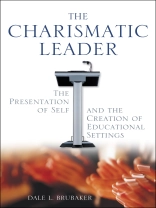‘Future generations of educational leaders will be in debt to Brubaker . . . The book is realistic, clear, and sensitive to the needs of practitioners on the firing line.’
—Lawrence Simon, Professor
Elon University
Discover the attitudes, behaviors, and skills that will help you become a more dynamic communicator in any situation!
Why do some educators have the ability to inspire while others barely hold the attention of staff, parents, or seminar participants? How should you present ideas to ensure the most success in effecting change? Discover the oft-overlooked but critical civilities of leadership that will give you a distinct edge. Using vignettes and thought-provoking exercises, Brubaker illustrates the rituals, attitudes, and skills successful leaders exhibit, allowing them to make meaningful connections with audiences and foster positive and productive school cultures.
The Charismatic Leader offers sage advice for getting the most out of every interaction, whether a one-on-one conversation, interview, or presentation to a large group. Beginning with the ‘table manners of leadership, ‘ Brubaker pinpoints essential skills that promote the effective exchange of information and better relationships including:
- Listening carefully to absorb details and discover hidden messages
- Focusing on the task at hand to choose the most appropriate communication strategy
- Preparing and rehearsing for flawless personal presentation
- Team building using techniques that foster collaboration and motivation
Make every interaction count—and build ties that will make a positive and lasting difference in your organization!
Tabela de Conteúdo
Preface
Acknowledgments
About the Author
Prologue: A Cautionary Tale
1. The Civilities of Leadership: Attitudes, Behaviors, Tools, and Skills
The Table Manners of Leadership
Concluding Advice From a Political Professional
Barriers to Creating a Culture of Civilities
Conclusion
Suggested Readings
2. Teams, Teaming, and the Creation of Educational Settings
Benefits of Teaming
Creating Positive Classroom and School Environments
Connecting the Classroom and School With the Outside World
The Thesis
Growing a Team
Formation of the Core Group
Key Features of the Educational Change Process Facing Team Leaders
Conclusion
Suggested Readings
3. Professional Development on the Presentation of Self and the Creation of Educational Settings
Definitions of Professional Development
Today′s Management by Mandate
Professional Development Revisited
Basic Assumptions Underlying Professional Development
Educators Have to Get to Give
Curiosity and Passion for Learning Are Contagious
Valuable Payoff a Critical Factor
Risk-Taking and Mistake-Making Are Keys to Learning
Presentation-of-Self Programs Take Time
Integration of Sources of Power a Key to Decision Making
Professional Development Plans
Conclusion
Suggested Readings
Appendices
References
Index
Sobre o autor
Dale L. Brubaker is Professor of Education at the University of North Carolina at Greensboro. He has also served on the faculties of the University of California, Santa Barbara, and the University of Wisconsin, Milwaukee. He received his doctorate in foundations of education from Michigan State University. He is the author or coauthor of numerous books on education and educational leadership, including CREATIVE CURRICULUM LEADERSHIP (Corwin), STAYING ON TRACK, (Corwin), and CREATIVE SURVIVAL IN EDUCATIONAL BUREAUCRACIES.











